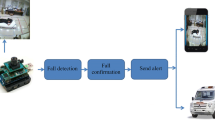Abstract
In recent years, fall detection, especially for the elderly living alone at home, is a challenge in the field of computer vision and pattern recognition. However, there is a concern of loss of privacy in intelligent visual surveillance. In order to solve the contradiction between security surveillance and privacy protection in vision-based fall detection methods, we propose a concept named visual shielding, which can be applied to eliminate visual information but not reduce monitoring function. In the preprocessing, the multilayer compressed sensing is used to compress video frames to achieve visual shielding effect. Then, object region is separated from shielded videos by the low-rank and sparse decomposition theory, based on which to extract motion trajectory features of the object via the dense trajectory algorithm. Finally, the fall detection issue is transformed into the sparse recognition problem of the signal. Experimental results on three public fall databases show that the specificity and sensitivity of the proposed method can be maintained at an ideal level, which has the dual advantages of high privacy protection and high recognition accuracy.






Similar content being viewed by others
References
Ambrose, A.F., Paul, G., Hausdorff, J.M.: Risk factors for falls among older adults: a review of the literature. Maturitas 75(1), 51–61 (2013)
Noury, N., Rumeau, P., Bourke, A.K., óLaighin, G., Lundy, J.E.: A proposal for the classification and evaluation of fall detectors. Irbm 29(6), 340–349 (2008)
Igual, R., Medrano, C., Plaza, I.: Challenges, issues and trends in fall detection systems. Biomed. Eng. Online 12(1), 66–66 (2013)
Mousse, M.A., Motamed, C., Ezin, Eugène, C.: Percentage of human-occupied areas for fall detection from two views. Vis. Comput. 33(12), 1529–1540 (2017)
Tao, J., Turjo, M., Wong, M.F., Wang, M., Tan, Y.P.: Fall incidents detection for intelligent video surveillance. In: 5th IEEE International Conference on Information, Communications and Signal Processing, pp. 1590–1594 (2005)
Mastorakis, G., Makris, D.: Fall detection system using Kinect’s infrared sensor. J. Real Time Image Process. 9(4), 635–646 (2014)
Li, Y., Ho, K.C., Popescu, M.: A microphone array system for automatic fall detection. IEEE Trans. Biomed. Eng. 59(5), 1291–1301 (2012)
Zhong, Z., Conly, C., Athitsos, V.: A survey on vision-based fall detection. In: ACM International Conference on Pervasive Technologies Related to Assistive Environments, pp. 1–7 (2015)
Debard, G., Karsmakers, P., Deschodt, M., Vlaeyen, E., Dejaeger, E., Milisen, K. et al.: Camera-Based fall detection on real world data. In: Theoretical Foundations of Computer Vision, pp. 356–375 (2012)
Auvinet, E., Multon, F., Saint-Arnaud, A., Rousseau, J., Meunier, J.: Fall detection with multiple cameras: an occlusion-resistant method based on 3-d silhouette vertical distribution. IEEE Trans. Inf. Technol. Biomed. 15(2), 290–300 (2011)
Donoho, D.L.: Compressed sensing. IEEE Trans. Inf. Theory 52(4), 1289–1306 (2006)
Emmanuel, J., Candès, Li, X., Ma, Y., Wright, J.: Robust principal component analysis? J. ACM 58(3), 1–37 (2011)
Wang, H., Kläser, A., Schmid, C., Liu, C.L.: Dense trajectories and motion boundary descriptors for action recognition. Int. J. Comput. Vis. 103(1), 60–79 (2013)
Shoaib, M., Dragon, R., Ostermann, J.: View-invariant fall detection for elderly in real home environment. In: Proceedings of the Fourth Pacific-Rim Symposium on Image Video Technology, pp. 52–57 (2010)
Dafeng, W., Yongkui, L., Shuang, L., Wenxing, B., Wei, W.: Abnormal behavior recognition of fall in surveillance video. Electron. Des. Eng. 24(22), 1126–1222 (2016)
Mirmahboub, B., Samavi, S., Karimi, N., Shirani, S.: Automatic monocular system for human fall detection based on variations in silhouette area. IEEE Trans. Biomed. Eng. 60(2), 427–436 (2013)
Rougier, C., Meunier, J., St-Arnaud, A., Rousseau, J.: Robust video surveillance for fall detection based on human shape deformation. IEEE Trans. Circuits Syst. Video Technol. 21(5), 611–622 (2011)
Foroughi, H., Aski, B.S., Pourreza, H.: Intelligent video surveillance for monitoring fall detection of elderly in home environments. In: IEEE International Conference on Computer and Information Technology, pp. 219–224 (2008)
Zerrouki, N., Houacine, A.: Combined curvelets and hidden Markov models for human fall detection. Multimed. Tools Appl. 77, 6405–6424 (2018)
Qian, H., Mao, Y., Xiang, W., Wang, Z.: Home environment fall detection system based on a cascaded Multi-SVM classifier. In: International Conference on Control, Automation, Robotics and Vision, pp. 1567–1572 (2008)
Anderson, D., Keller, J.M., Skubic, M., Chen, X., He, Z.: Recognizing falls from silhouettes. In: International Conference of the IEEE Engineering in Medicine and Biology Society. pp. 6388–6391 (2006)
Charfi, I., Miteran, J., Dubois, J., Atri, M., Tourki, R.: Definition and performance evaluation of a robust SVM based fall detection solution. In: International Conference on Signal Image Technology and Internet Based Systems, pp. 218–224 (2012)
Poonsri, A., Chiracharit,W.: Fall detection using Gaussian mixture model and principle component analysis. In: 2017 9th International Conference on Information Technology and Electrical Engineering (ICITEE), pp. 1–4 (2017)
Kwolek, B., Kepski, M.: Human fall detection on embedded platform using depth maps and wireless accelerometer. Comput. Methods Prog. Biomed. 117(3), 489–501 (2014)
Wang, S., Chen, L., Zhou, Z., Sun, X., Dong, J.: Human fall detection in surveillance video based on pcanet. Multimed. Tools Appl. 75(19), 11603–11613 (2016)
Chua, J.L., Chang, Y.C., Lim, W.K.: A simple vision-based fall detection technique for indoor video surveillance. Signal Image Video Process. 9(3), 623–633 (2015)
Lee, T., Mihailidis, A.: An intelligent emergency response system: preliminary development and testing of automated fall detection. J. Telemed. Telecare 11(4), 194–198 (2005)
Mubashir, M., Shao, L., Seed, L.: A survey on fall detection: principles and approaches. Neurocomputing 100, 144–152 (2013)
Rougier, C., Meunier, J.: Demo: Fall detection using 3d head trajectory extracted from a single camera video sequence. In: Proceedings of the First International Work-shop on Video Processing for Security (2006)
Candes, E.J., Tao, T.: Decoding by linear programming. IEEE Trans. Inf. Theory 51(12), 4203–4215 (2005)
Zha, Z., Liu, L., Zhang, X.: Compressed sensing image reconstruction via adaptive sparse nonlocal regularization. Vis. Comput. 34(1), 117–137 (2018)
Emmanuel, JCandès: The restricted isometry property and its implications for compressed sensing. C. R. Math. 346((9–10)), 589–592 (2008)
Gan, L.: Block compressed sensing of natural images. In: IEEE International Conference on Digital Signal Processing, pp. 403–406 (2007)
Jixin, L., Quansen, S.: Chaotic cellular automaton for generating measurement matrix used in CS coding. IET Signal Process. 11(1), 115–122 (2017)
ORL face database. https://www.cl.cam.ac.uk/research/dtg/attarchive/face database.html. Accessed 16 Nov 2018
Wright, J., Ganesh, A., Zhou Z, Wanger, A., Ma, Y.: Demo: Robust face recognition via sparse representation. In: IEEE International Conference on Automatic Face and Gesture Recognition, pp. 1–2 (2009)
Weinland, D., Ronfard, R., Boyer, E.: A survey of vision-based methods for action representation, segmentation and recognition. Comput. Vis. Image Underst. 115(2), 224–241 (2011)
Ji, S., Xu, W., Yang, M., Yu, K.: 3D convolutional neural networks for human action recognition. IEEE PAMI 35(1), 221–231 (2013)
Xue, Z., Dong, J., Zhao, Y., Liu, C., Chellali, R.: Low-rank and sparse matrix decomposition via the truncated nuclear norm and a sparse regularizer. Vis. Comput. 35, 1549–1566 (2019)
Zhou, T., Tao, D.: GoDec: randomized low rank and sparse matrix decomposition in noisy case. Int. Conf. Mach. Learn. 31(6), 33–40 (2011)
Daniilidis, K., Maragos, P., Paragios, N.: improving the fisher kernel for large-scale image classification. ECCV 13, 143–156 (2010)
Bartlett, M.S., Movellan, J.R., Sejnowski, T.J.: Face recognition by independent component analysis. IEEE Trans. Neural Netw. 13(6), 1450–64 (2012)
Patel, V.M., Wu, T., Biswas, S., Phillips, P.J., Chellappa, R.: Dictionary-based face recognition under variable lighting and pose. IEEE Trans. Inf. Forensics Secur. 7(3), 954–965 (2012)
Jixin, L., Quansen, S.: Sparse recognition via intra-class dictionary learning using visual saliency information. Neurocomputing 196, 70–81 (2016)
Kwolek, B., Kepski, M.: Improving fall detection by the use of depth sensor and accelerometer. Neurocomputing 168, 637–645 (2015)
Auvinet, E., Rougier, C., Meunier, J., St-Arnaud, A., Rousseau,J.: Multiple cameras fall data set. Technical Report 1350. DIRO Université de Montréal (2010)
Funding
This work was supported by funds from the Provincial Natural Science Foundation of the Science and Technology Bureau of Jiangsu Province (Grant No. BK20180088), the China Postdoctoral Science Foundation (Grant No. 2019M651916), the Scientific Research Foundation of Nanjing University of Posts and Telecommunications (Grant No. NY218066) and the Postgraduate Research & Practice Innovation Program of Jiangsu Province (Grant No. KYCX18_0919).
Author information
Authors and Affiliations
Corresponding author
Ethics declarations
Conflict of interest
The authors declare that they have no conflict of interest.
Additional information
Publisher's Note
Springer Nature remains neutral with regard to jurisdictional claims in published maps and institutional affiliations.
Rights and permissions
About this article
Cite this article
Liu, J., Xia, Y. & Tang, Z. Privacy-preserving video fall detection using visual shielding information. Vis Comput 37, 359–370 (2021). https://doi.org/10.1007/s00371-020-01804-w
Published:
Issue Date:
DOI: https://doi.org/10.1007/s00371-020-01804-w




